Your cart is currently empty!
The 5 Stages of a Blue Ocean Shift Innovation- Revisited
Blue Ocean Shift Innovation
Never has there been a better time to unleash innovation in your organisation. There is a perfect storm that offers: an unprecedented amount of talented and entrepreneurial young people; accessible technology- many of it for free; and a colliding of ground-breaking knowledge which gives us a clear route forward; and customers who are accessible, around the world, because they are only a few clicks away from ordering.
Internal and external innovation:
- Gemba Kaizen innovation (innovation at the workface is a daily activity) which focuses on improving internal processes as a daily activity.
- Blue ocean innovation where an organisation moves away from the cut throat, dog eat dog bloody red oceans of competition to the clear, calm and rewarding waters.
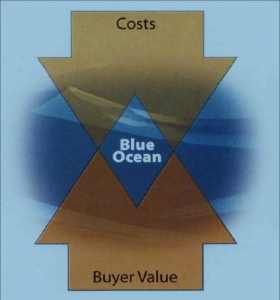
In the book the “Blue Ocean Shift” process Kim and Mauborgne have outlined a very practical five step process for moving from the bloody red oceans of competition to the clear, calm and rewarding blue oceans.
You know when you are there as there is little or no competition, customers have a higher perceived value and are thus fans, costs are lower.
They are very clear about their advice:
Focus on new demand rather than fighting over existing customers This is a zero-sum game. In New Zealand the power companies knock on your door offering great deals to switch. It is an endless circle which the main beneficiary is the clever consumer who players them off against each other.
Do not take existing industry conditions as givens “It is because they say it is”, All great products or services start by challenging this statement. Invariably nobody has asked the customer. The status quo is assumed by the management who have received large bonuses from the existing environment and are not in a frame of mind to look for new possibilities.
Have a mantra that Noncustomers’ come first Peter Drucker coined the phrase “non customers”. By focusing on all those customers who you would like to have but have not yet engaged an organisation can challenge the past and look for new opportunities and new channels to reach this untapped potential.
Do not seek to beat the competition- aim to make them irrelevant Fighting over the same customers is a meaningless task. You want an offering where your customers are fans. No amount of enticement will change their purchasing habits. Apple has succeeded with this time and time again.
The five-stage model
- Get started: This step involves selecting a BOS facilitator, who will be an outside consultant, selecting the core inhouse BOS team, and training them. Selecting some mentors for the inhouse team. Mapping out your current offerings in the pioneer-migrator-settler process.
- Understand where you are now: This involves the BOS facilitator running a two-day workshop with the extended BOS team. The Strategy canvas is drawn. Expect this to take 2-4 weeks to schedule.
- Imagine where you could be: This involves the extended BOS team doing field work, and meeting up in a one day workshop where they share their findings on the buyer utility matrix and ascertain the magnitude of the three types non-customers’ demand ( “soon to be non-customers”, “refusing non-customers” and “unexplored non-customers”.
- Find how you get there: This involves the extended BOS team doing fieldwork and meeting up in a one-day workshop where they share their findings on the six possible paths, complete the eliminate, reduce, raise and create key features exercise and outline a number of possible new offering solutions.
- Make your move: This involves the extended BOS team presenting the “new offerings” in a contestable environment (a blue ocean fair), where the chosen audience get to hear the various options and in a workshop environment explore their options .get to add their contribution and then vote for the best offerings from their perspective all on the same day. The executive team then makes their decision. Piloting of the new product or service commences with great speed with carefully chosen responsive customers / regions.
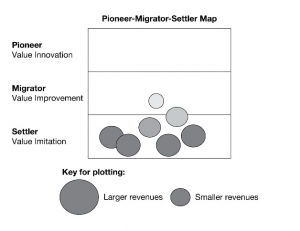
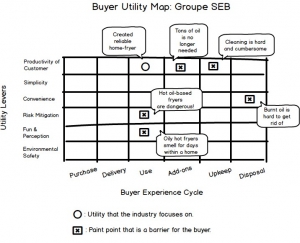
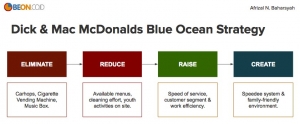
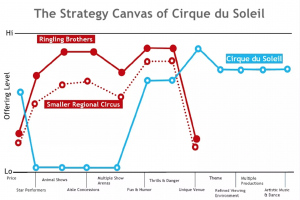
Purchase David Parmenter’s ‘Expert’ Article which is on sale at USD 29.90 and comes with 15 electronic templates.
A ‘look inside’ the Innovation Toolkit:
Contents page
A perfect storm 2
Understanding Gemba Kaizen Innovation 3
- Housekeeping 3
- Waste elimination 5
- Visual management 7
- Adopting winning methods 7
Blue Ocean Innovation 8
The five-step Blue Ocean Shift Model 9
- Step 1: Get started 9
- Step 2: Understand Where You Are Now 18
- Step 3: Imagine where you could be 22
- Step 4: Find how you get there 24
- Step 5: Choose and make the blue ocean move 28
Selling and Leading Change. 31
- Steve Zaffron and Dave Logan 31
- Harry Mills’ Self Persuasion 32
- John Kotter’s Leading Change 32
- Selling A BOS Project to the Senior Management Team 33
- Learn to Sell by Using the Emotional Drivers of the Buyer 34
- The Elevator Speech 34
- Deliver a Compelling Burning Platform Presentation 35
Wisdom from the great management thinkers. 37
- Peter Drucker’s Lessons on Innovation 38
- Jim Collins’s Lessons for Innovation 42
- Jack Welch’s Lessons for Innovation 42
- Thomas Peters and Robert Waterman’s Lessons for Innovation 43
- Gary Hamel’s Lessons for Innovation 43
- Jeremy Hope’s Lessons for Innovation 44
- Tom Peters’ Lessons for Innovation 44
E-Templates
- Establishing a BOS Project Team Checklist 48
- Establishing BOS Team Questionnaire 50
- BOS Team 360-Degree Questionnaire 53
- “Just Do It” Culture and Process Checklist 55
- Job Description for the BOS Team Leader 56
- Skills and experience 56
- Workshop Preparation Checklist 58
- Guidelines to Running Workshops 60
The ‘Expert’ Article can be purchased from